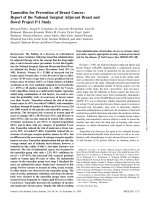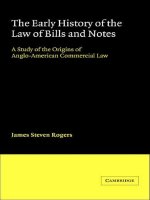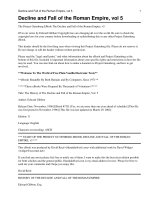History of the Comstock Patent Medicine Business and Dr. Morse''''s Indian Root Pills, by Robert B. Shaw pot
Bạn đang xem bản rút gọn của tài liệu. Xem và tải ngay bản đầy đủ của tài liệu tại đây (3.24 MB, 299 trang )
The Project Gutenberg EBook of History
of the Comstock Patent Medicine
Business and Dr. Morse's Indian Root
Pills, by Robert B. Shaw
This eBook is for the use of anyone
anywhere at no cost and with
almost no restrictions whatsoever. You
may copy it, give it away or
re-use it under the terms of the Project
Gutenberg License included
with
this
eBook
or
online
at
www.gutenberg.net
Title: History of the Comstock Patent
Medicine Business and Dr. Morse's Indian
Root Pills
Author: Robert B. Shaw
Release Date: September 8, 2004 [EBook
#13397]
[Last updated: September 21, 2011]
Language: English
*** START OF THIS PROJECT GUTENBERG
EBOOK COMSTOCK PATENT MEDICINE ***
Produced by Bryan Ness and the Online
Distributed Proofreading Team.
HISTORY
of the
COMSTOCK PATENT
MEDICINE
BUSINESS
and Dr. Morse's Indian
Root Pills
BY
Robert B. Shaw
Associate Professor, Accounting and
History
Clarkson College of Technology
Potsdam, N.Y.
SMITHSONIAN STUDIES IN
HISTORY AND TECHNOLOGY
NUMBER 22
COVER:
Changing
methods
of
packaging Comstock remedies over the
years.—Lower left: Original packaging
of the Indian Root Pills in oval veneer
boxes. Lower center: The glass bottles
and cardboard and tin boxes. Lower
right: The modern packaging during the
final years of domestic manufacture.
Upper left: The Indian Root Pills as they
are still being packaged and distributed
in Australia. Upper center: Dr.
Howard's Electric Blood Builder Pills.
Upper right: Comstock's Dead Shot
Worm Pellets.
*****
Library of Congress Cataloging in
Publication Data
Shaw, Robert B., 1916—
History of the Comstock patent medicine
business and of Dr. Morse's Indian Root
Pills. (Smithsonian studies in history and
technology, no. 22)
Bibliography: p.
1. Comstock (W.H.) Company. I. Title.
II. Series: Smithsonian Institution.
Smithsonian studies in history and
technology, no. 22.
HD9666.9.C62S46 338.7'6'615886 76
39864
*****
Official publication date is
handstamped in a limited number of
initial copies and is recorded in the
Institution's annual report,
Smithsonian Year.
For sale by the Superintendent of
Documents, U.S. Government Printing
Office Washington, D.C. 20402—
Price 65 cents (paper cover) Stock
Number 4700-0204
Comstock Family
Tree
History of the
Comstock Patent
Medicine Business and
of Dr. Morse's Indian
Root Pills
For nearly a century a conspicuous
feature of the small riverside village of
Morristown, in northern New York
State, was the W.H. Comstock factory,
better known as the home of the
celebrated Dr. Morse's Indian Root
Pills. This business never grew to be
more than a modest undertaking in
modern industrial terms, and amid the
congestion of any large city its few
buildings straddling a branch railroad
and its work force of several dozens at
most would have been little noticed, but
in its rural setting the enterprise
occupied a prominent role in the
economic life of the community for over
ninety years. Aside from the omnipresent
forest and dairy industries, it
represented the only manufacturing
activity for miles around and was easily
the largest single employer in its village,
as well as the chief recipient and
shipper of freight at the adjacent railroad
station. For some years, early in the
present century, the company supplied a
primitive electric service to the
community, and the Comstock Hotel,
until it was destroyed by fire, served as
the principal village hostelry.
But the influence of this business was by
no means strictly local. For decades
thousands of boxes of pills and bottles of
elixir, together
with advertising
circulars and almanacs in the millions,
flowed out of this remote village to
druggists in thousands of communities in
the United States and Canada, in Latin
America, and in the Orient. And Dr.
Morse's Indian Root Pills and the other
remedies must have been household
names wherever people suffered aches
and infirmities. Thus Morristown,
notwithstanding its placid appearance,
played an active role in commerce and
industry throughout the colorful patentmedicine era.
Today, the Indian Root Pill factory
stands abandoned and forlorn—its
decline and demise brought on by an age
of more precise medical diagnoses and
the more stringent enforcement of
various food and drug acts. After
abandonment, the factory was ransacked
by vandals; and records, documents,
wrappers, advertising circulars, pills
awaiting packaging, and other effects
were thrown down from the shelves and
scattered over the floors. This made it
impossible to recover and examine the
records systematically. The former
proprietors of the business, however,
had for some reason—perhaps sheer
inertia—apparently preserved all of
their records for over a century, storing
them in the loft-like attic over the
packaging building. Despite their
careless treatment, enough records were
recovered to reconstruct most of the
history of the Comstock enterprise and to
cast new light upon the patent-medicine
industry of the United States during its
heyday.
The Comstock business, of course, was
far from unique. Hundreds of
manufacturers of proprietary remedies
flourished during the 1880s and 1890s
the Druggists' Directory for 1895 lists
approximately 1,500. The great majority
of these factories were much smaller
than Comstock; one suspects, in fact, that
most of them were no more than
backroom enterprises conducted by
untrained, but ambitious, druggists who,
with parttime help, mixed up some
mysterious concoctions and contrived
imaginative advertising schemes. A few
of these businesses were considerably
larger than Comstock.
The Origin of the Business
The Indian Root Pill business was
carried on during most of its existence
by two members of the Comstock family
—father and son—and because of
unusual longevity, this control by two
generations extended for over a century.
The plant was also located in
Morristown for approximately ninety
years. The Indian Root Pills, however,
were not actually originated by the
Comstock family, nor were they
discovered in Morristown. Rather, the
business had its genesis in New York
City, at a time when the city still
consisted primarily of two-or three-story
buildings and did not extend beyond the
present 42nd Street.
According to an affidavit written in
1851—and much of the history of the
business is derived from documents
prepared in connection with numerous
lawsuits—the founder of the Comstock
drug venture was Edwin Comstock,
sometime in or before 1833. Edwin,
along with the numerous other brothers
who will shortly enter the picture, was a
son of Samuel Comstock, of Butternuts,
Otsego County, New York. Samuel, a
fifth-generation descendant of William
Comstock, one of the pioneer settlers of
New London, Connecticut, and ancestor
of most of the Comstocks in America,
was born in East Lyme, Connecticut, a
few years before the Revolution, but
sometime after the birth of Edwin in
1794 he moved to Otsego County, New
York.
Edwin, in 1828, moved to Batavia, New
York, where his son, William Henry
Comstock, was born on August 1, 1830.
Within four or five years, however,
Edwin repaired to New York City,
where he established the extensive drug
and medicine business that was to be
carried on by members of his family for
over a century. Just why Edwin
performed this brief sojourn in Batavia,
or where he made his initial entry into
the drug trade, is not clear, although the
rapid growth of his firm in New York
City suggests that he had had previous
experience in that field. It is a plausible
surmise that he may have worked in
Batavia in the drug store of Dr. Levant
B. Cotes, which was destroyed in the
village-wide fire of April 19, 1833; the
termination of Edwin's career in Batavia
might have been associated either with
that disaster or with the death of his wife
in 1831.
The Comstocks also obviously had some
medical tradition in their family.
Samuel's younger brother, John Lee
Comstock, was trained as a physician
and served in that capacity during the
War of 1812—although he was to gain
greater prominence as a historian and
natural philosopher. All five of Samuel's
sons participated at least briefly in the
drug trade, while two of them also had
careers as medical doctors. A cousin of
Edwin, Thomas Griswold Comstock
(born 1829), also became a prominent
homeopathic physician and gynecologist
in St. Louis.[1] It might also be
significant that the original home of the
Comstock family, in Connecticut, was
within a few miles of the scene of the
discovery of the first patent medicine in
America—Lee's "Bilious Pills"—by Dr.
Samuel Lee (1744-1805), of Windham,
sometime prior to 1796.[2] This
medicine enjoyed such a rapid success
that it was soon being widely imitated,
and the Comstocks could not have been
unaware of its popularity.
So it seems almost certain that Edwin
was no longer a novice when he
established his own drug business in
New York City. Between 1833 and 1837
he employed his brother, Lucius S.
Comstock (born in 1806), as a clerk, and
for the next fifteen years Lucius will
figure very conspicuously in this story.
He not merely appended the designation
"M.D." to his name and claimed
membership in the Medical Society of
the City of New York, but also
described himself as a Counsellor-atLaw.
Edwin, the founder of the business, did
not live long to enjoy its prosperity—or
perhaps we should say that he was
fortunate enough to pass away before it
experienced its most severe vicissitudes
and trials. After Edwin's death in 1837,
Lucius continued the business in
partnership with another brother, Albert
Lee, under the style of Comstock & Co.
Two more brothers, John Carlton (born
1819) and George Wells (born 1820),
were employed as clerks.
FIGURE 1.—Original wrapper for Carltons
Liniment, 1851.
The partnership of Comstock & Co.
between Lucius and Albert was
terminated by a dispute between the two
brothers in 1841, and Albert went his
own way, taking up a career as a
physician and living until 1876. Lucius
next went into business with his motherin-law, Anne Moore, from 1841 to 1846;
after the dissolution of this firm, he
formed a new partnership, also under the
name of Comstock & Co., with his
brother John (generally known as J.
Carlton). This firm again employed as
clerks George Wells Comstock and a
nephew, William Henry, a son of Edwin.
William Henry was to eventually
become the founder of the business at









